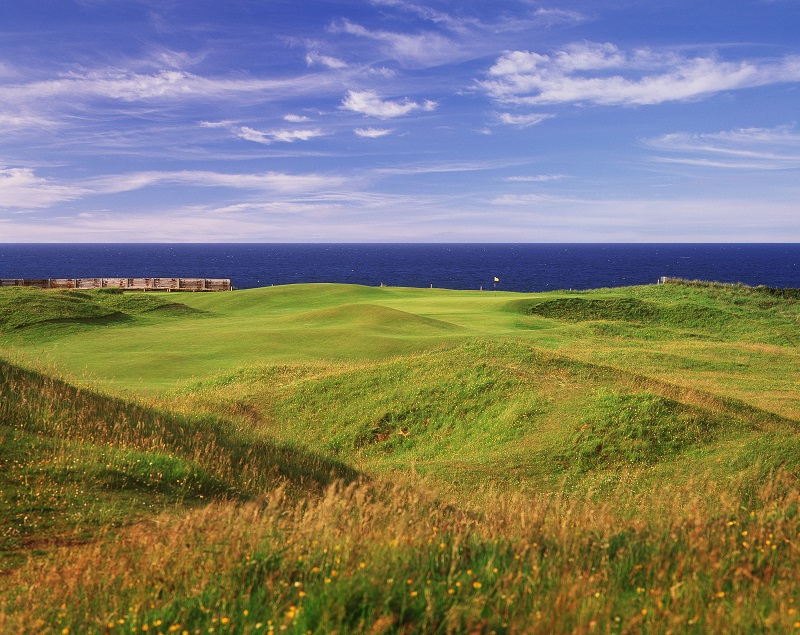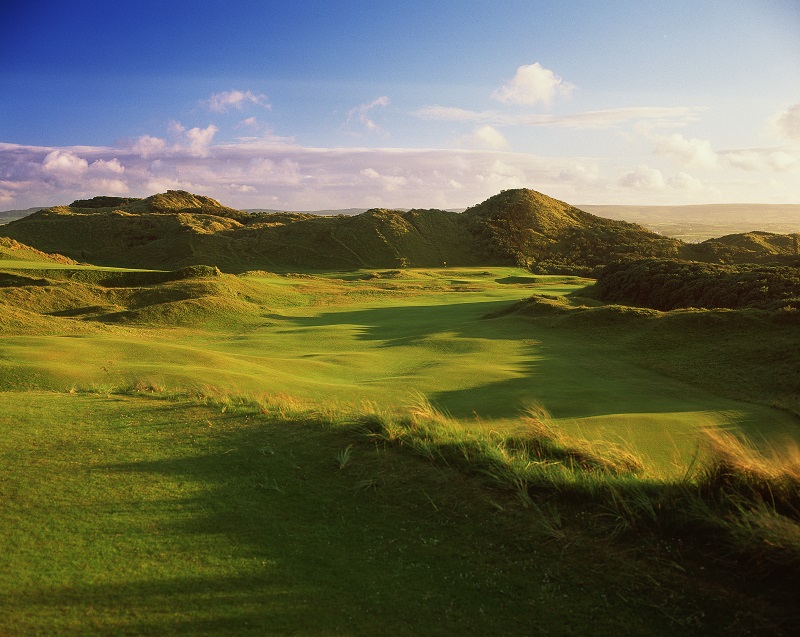“What’s in it?” I asked, peering at the silver hip flask being offered to me.
Tommy had produced it from the depths of his bag on the 12th hole at Castlerock, and after pouring a shot and knocking it back with an exaggerated sigh of contentment, he handed it to me.
“Trade secret” he replied with a grin and a raised eyebrow, “but it’ll put hairs on your chest.”
The sun was out, the sea dazzled in the light and my golfing companions – Tommy, Cedric and Jimmy – had proved entertaining company since they’d invited me to join them on the second hole. Now, Cedric and Jimmy stood with their arms folded watching to see what I’d do.
After a pause I reached out and took it.
Sure, why wouldn’t you! It was one more reason why I was enjoying my Northern Irish adventure, because no matter how you look at it the joy of this island as a golfing destination comes down to three things:
First, the quality of the courses is second to none. That is, irrefutably, the key criterion in the destination decision-making process. When you look at the courses dotted along this stretch of northern coastline from Co. Derry to Co. Antrim, it’s not hard to see why golfers flock here.
Second, you’ve got the weather. True, it’s not exactly a key factor when choosing a trip to Ireland, because you could be basking in glorious February sunshine or saving your hotel’s water bill by taking soap on to the course for an impromptu August shower. Our weather doesn’t have the reliability of Iberia or Turkey, but if you’re lucky enough to get a week of perfect sun then you’ve been blessed, and you can return home with red skin and the knowledge that it’s so unexpected there was no suntan lotion in the shops.
And then there’s the third reason… a reason that is repeated ad nauseum on advertising campaigns, tourism websites and in guide books… a term so clichéd even the Irish blush with embarrassment.
Yes, I’m talking about ‘the craic’.
We bang on about it so much, tourists expect leprechauns to be directing traffic at motorway junctions, while the girls and boys of Riverdance kick up their heels in every pub in the land to celebrate the rows of Guinness lining the bar.
Here’s a little secret… we don’t have leprechauns… and there won’t be nightly performances of Riverdance, but when you come to Ireland you’ll discover that the craic is alive and well… and it’s expecting your company in every golf club, restaurant, pub and on every street.

Here’s another secret… you don’t have to be Irish to enjoy the craic. Simply get into the spirit of things and join in. Whether you’re a lone golfer, in a convenient fourball or part of a large group, take a few moments after your round and sit yourself down in the clubhouse bar. Say a few kind words about the course in any direction you choose, and wait for a reply. Someone will surely jump at the opportunity to bend your ear with the club’s history, stories of golfing skulduggery or tales that are so tall they are utterly irresistible. You’ll learn a lot, laugh a lot and, who knows, you may find yourself whisked off to someone’s house for dinner, down to the local bar for some live Irish music, or back on the course for a format you won’t understand that involves money you will undoubtedly lose.
The thing is, the craic is about you enjoying yourself, whether you’re with your compatriots or having fun with your Irish hosts. It’s not a magic formula. It’s just the way we embrace life, and the folks of Northern Ireland will do their best to make sure you do the same.
Which was why, after being offered the hand of friendship by three Northern Irish golfers I’d never met, it would have been churlish of me to refuse a drink from that silver flask. As the wind snapped around my ankles and chilled my cheeks, I found the deep red liquid seductive and exquisite on the tongue. How did it go down? I can do no more than suggest you take a three iron and hit yourself in the back of the head. It was that good.
What’s in it? Sorry to say I’m not allowed to tell you, but when you’re up this way be sure to ask for some of Bishop Daly’s special brew. And believe me, after that you’ll discover the craic is truly mighty.

Castlerock:
The 18-hole Mussenden Links may live in the shadow of Castlerock’s illustrious neighbours, but the course still offers a thrilling links experience. Starting in the dunes it heads out to the open spaces where you’ll encounter the River Bann and the railway line. It may feel more gentle out here, before you return to the wrath of the bigger dunes, but the fairways are every bit as bumpy and mischievous, and the greens as slick and tricky. The par three 4th hole, named Leg of Mutton, is close to 200 yards with a creek left, railway line right and a raised green. Holding the green is an achievement in itself.
For most visiting golfers, however, it is the start and finish that prove magnetic. Here the dunes are bigger and more erratic, creating a run of holes that wind back and forth, as well as up and down. Smart doglegs, smarter bunkering and deep rough abound. Tee shots give you room and don’t call for the strategy required at nearby Royal Portrush, but approaching the lightning quick greens places a premium on subtlety and soft hands. Greens are tucked into the dunes – such as the 7th, aptly named Armchair – or sitting on slight plateaux with sharp run-offs, so bravery is required the whole way around.

And then there’s the wind, which will usually be straight into you on several of the tough holes. It will keep you challenged… and sometimes bemused… but always entertained. There is also the stunning 9-hole Bann course.
Portstewart (Strand):
With an opening nine holes through dunes called ‘God’s Own Country’, you know you’re in for some thrills at Portstewart. The 1st hole is widely regarded as the best opener on the island. From the tee there are views along the Northern coastline to Mussenden Temple and the Inishowen peninsula, and your drive hits down to a fairway that whips right and out of sight. It sets the pulse racing and rarely lets up until you reach the more sedate closing holes.

You always see what’s in front of you – quite remarkable considering the terrain you play over – and that makes driving a particularly pleasant experience. Despite those early dunes, the course can feel open, even spacious, and the natural green sites promise wonderful approach shots. It is by no means easy, but it is definitely playable.
The spaciousness offers views down to the River Bann and beyond and standing on the 5th tee with the hole below and views laid out ahead of you is almost as inspiring as arriving on the 1st tee.
A new clubhouse adds hugely to the experience and while there are two more 18 hole courses here, the Strand is the main event which has to be played.
Royal Portrush (Dunluce):
A course forever spoken about as one of the world’s best and the only venue outside mainland Britain to host the Open Championship (1951). Royal Portrush is on every golfer’s bucket list. Set on the edge of the small Portrush town there is a rich history that dates back to 1888, and the name of Harry Colt runs deep in the club’s veins. The course is renowned for many reasons, but two of the most obvious are the strategic brilliance golfers face and the acclaimed par three 14th hole, named Calamity Corner.
Royal Portrush requires precise tee shots if golfers are to open up the greens. Few holes are straight and if you’re on the wrong side of the fairway – let alone in the rough – par can still evaporate before your eyes. Attacking the greens is never easy. A caddie is useful on a links course but here it should be a pre-requisite. Maybe you’ll feel confident that you can sail along on your own as the changes in elevation create few blind shots (such as those at Royal County Down), but that would be misguided. The par four 5th will make that abundantly clear. This is a dogleg and the most beautiful part of the course with views of cliffs, sea and Skerries Reef. It is not a long hole but the dogleg is so tempting that you will probably bite off more than you can chew… even when you don’t need to. No, a caddie here will save you a dozen shots.
The 14th is a brute of a 202 yard par three. A chasm sits along the right, all the way to the green. The flag flaps on the skyline, calling to you like a siren, but there is an opt out to the left… and you should take it.
Take a stroll around the clubhouse and check out the photographs and the course record of 11 under par. It was scored by a 16 year old Rory McIlroy.
Royal Portrush (Valley):
Often forgotten in the clamour of adoration for the Dunluce links, the Valley course is a more sedate, low-lying affair. And yet it flashes with brilliance and is more accessible to golfers of all abilities. Sitting below the main course (you see much of it from Calamity) it looks flat and open, but it calls for cunning and the land is a lot less level than you imagine.
Tucked low in the dunes the wind will not prove so punishing here, but even though it’s a short par 70, guile is required. The less turbulent fairways will still wreak havoc, and with the thorny wild rose bushes around the backs of many greens, going long can be a prickly mistake. One of the beauties of the Valley is the minimalist design. The Dunluce is similarly natural, but the rhythm of the Valley is magnified by the landscape’s simplicity and such is eccentricity of the terrain that few bunkers are required. It is a perfect education in links golf and the art of bump and run – made all the more attractive by so many flags being on show from often elevated tees.
FOR ALL BOOKINGS, CONTACT:
North & West Coast Links
For more information and a variety of golf packages to play courses in Ireland's north and north west coastal regions please visit: http://www.northandwestcoastlinks.com